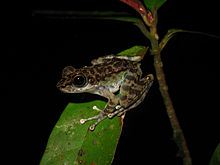Amolops
| Cascade frogs | |
|---|---|
 |
|
| Amolops panhai | |
| Scientific classification | |
| Kingdom: | Animalia |
| Phylum: | Chordata |
| Subphylum: | Vertebrata |
| Class: | Amphibia |
| Subclass: | Lissamphibia |
| Order: | Anura |
| Suborder: | Neobatrachia |
| Superfamily: | Ranoidea |
| Family: | Ranidae |
| Genus: |
Amolops Cope, 1865 |
| Species | |
|
Many, see text |
|
Many, see text
Amolops (commonly known as cascade frogs or sucker frogs) is a quite large genus of true frogs (family Ranidae) native mainly to eastern and southeastern Asia. These frogs are quite closely related to such genera as Huia, Meristogenys, Odorrana, Pelohylax and Rana, but still form a distinct lineage among the core radiation of true frogs. They are commonly known as "torrent frogs" after their favorite habitat - small rapid-flowing mountain and hill streams - but this name is used for many similar-looking frogs regardless of whether they are loosely related.
Several species are highly convergent with other Ranidae "torrent frogs". A. archotaphus and its relatives for example very much resemble Odorrana livida. In another incidence of convergent evolution yielding adaptation to habitat, the tadpoles of Amolops, Huia, Meristogenys as well as Rana sauteri have a raised and usually well-developed sucker on their belly. This is useful in keeping in place in rocky torrents, where these frogs grow up. But as Odorrana and Staurois from comparable habitat prove, this sucker is by no means a necessity and other means of adaptation to torrent habitat exist.
The delimitation of this genus has proven complicated, with many species believed to belong elsewhere. Due to the degree of convergent evolution, DNA sequence studies are very helpful in assigning species to the genera, though the possibility of past hybridization cannot be discounted in Ranidae.
...
Wikipedia
